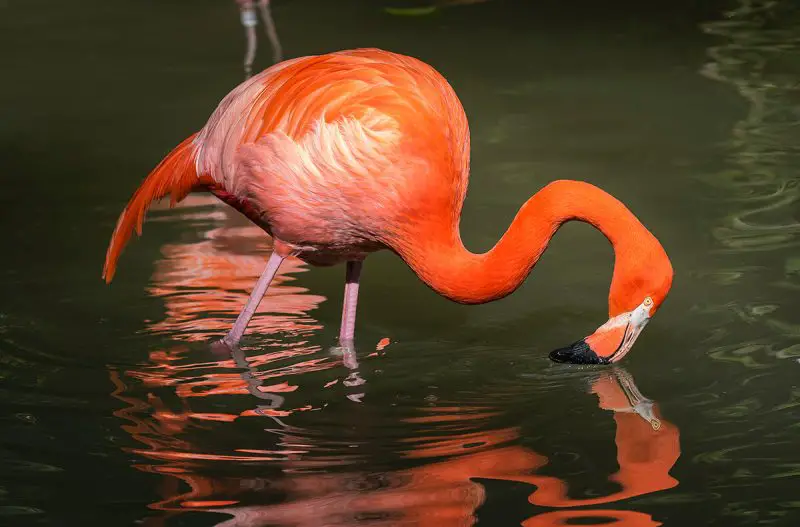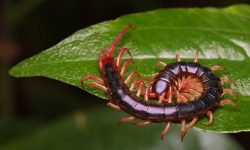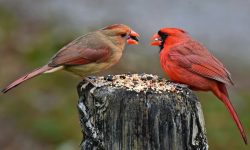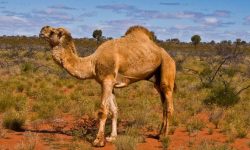Flamingos are some of the most recognizable birds in the world, famous for their striking pink feathers, long legs and graceful, synchronized movements across shallow wetlands. Their unusual appearance draws global fascination, but their feeding habits are just as interesting. Understanding what flamingos eat reveals the complex ecological relationships that shape their vibrant plumage and support their survival in salt flats, lagoons, estuaries and inland lakes.
Flamingos rely on a filter-feeding system unlike that of most birds. Their unique bills, perfectly adapted for sifting through water, mud and sediment, allow them to extract microscopic organisms and small aquatic animals that other species ignore. Their pink coloration comes directly from their diet, especially from carotenoid-rich foods like algae and brine shrimp. Without these pigments, flamingos would appear pale gray or white.
This guide dives deeply into 20 foods flamingos rely on in the wild, offering insight into how these elegant birds nourish themselves in some of the harshest and most nutrient-limited habitats on Earth. Their diet illustrates their adaptability, precision and dependence on abundant wetlands.
Understanding the Flamingo Diet

Flamingos are primarily filter feeders, meaning they obtain food by sweeping their beaks upside-down through water and mud. Their bills contain lamellae—fine comb-like structures that trap tiny organisms while allowing water and silt to escape. This feeding adaptation allows flamingos to extract microscopic algae, plankton, shrimp, insect larvae and small crustaceans that many birds cannot access.
Different flamingo species specialize in slightly different diets depending on habitat. Lesser flamingos consume mostly microscopic algae. Greater flamingos and Chilean flamingos rely more on crustaceans, mollusks and aquatic insects. These differences shape their coloration and influence where they live. Wetlands with high salinity or alkaline conditions often support large flamingo populations because fewer predators and competitors survive there.
Flamingos feed by stirring sediment with their feet, creating a cloud of particles that they sweep through with rhythmic side-to-side head movements. Their feeding behavior is highly coordinated and often performed in groups. Large flocks increase foraging efficiency and help flamingos locate nutrient-dense areas. This collective approach allows them to thrive in immense colonies across Africa, South America, the Middle East and southern Europe.
20 Foods Flamingos Rely on in the Wild
1. Blue-Green Algae
Blue-green algae, or cyanobacteria, are among the most important foods for certain flamingo species. These microscopic organisms grow abundantly in alkaline lakes and give flamingos much of their pink and red pigmentation.
Flamingos filter these algae from the upper layers of shallow water. They rely on lakes with high salinity where algae multiply rapidly due to low competition from other species. When algal blooms are strong, flamingos gather in large colonies to feed.
This food source provides carotenoids that support their vibrant coloration, immune health and reproductive success.
2. Spirulina
Spirulina is a nutrient-dense cyanobacterium that thrives in alkaline salt lakes—prime flamingo habitat. It contains high levels of carotenoids and proteins essential for flamingo feather color and overall vitality.
Flamingos sweep spirulina-rich water through their bills, trapping the fine strands inside their filter plates. During peak spirulina growth, these birds may spend hours feeding in concentrated areas.
Spirulina helps flamingos maintain energy levels during breeding seasons and long migrations.
3. Diatoms
Diatoms are microscopic algae with silica-rich cell walls. They flourish in shallow waters where sunlight penetrates easily. Flamingos consume diatoms by filtering water close to mud surfaces where these organisms accumulate.
These algae provide essential fatty acids that support metabolism and feather quality. Diatoms appear seasonally, creating cycles in flamingo feeding behavior.
In nutrient-rich wetlands, diatoms become a staple food that supports both adults and growing juveniles.
4. Brine Shrimp
Brine shrimp are famous for their role in enhancing flamingo coloration. Rich in carotenoids, these tiny crustaceans turn flamingo feathers shades of pink, coral and deep red depending on concentration in the diet.
Flamingos capture brine shrimp by sweeping their beaks through shallow salt ponds. Shrimp populations fluctuate with water levels, influencing flamingo flock movements.
Brine shrimp are especially important for breeding flamingos, providing energy-dense protein.
5. Brine Flies (Adults)
Brine flies thrive in alkaline lake margins where flamingos forage. Adult flies gather in dense clusters on the water’s surface, making them easily accessible prey.
Flamingos skim these flies off the top layer of water. Their quick head movements allow them to capture large numbers in a short period. These insects are rich in protein and moisture.
Brine flies contribute to flamingos’ diet during seasons when algae growth slows.
6. Brine Fly Larvae
Larvae of brine flies develop underwater and form dense mats on submerged surfaces. Flamingos rake these larvae from mud and water by filtering through fine sediment.
These larvae are soft-bodied and nutrient-rich, offering protein essential for chick growth. Flamingos often feed larvae to their young as a supplement to crop milk.
During certain seasons, larval feeding becomes central to flamingo survival.
7. Small Crustaceans
Flamingos consume a variety of small crustaceans including copepods, amphipods and tiny freshwater shrimps. These organisms inhabit shallow waters and are swept easily into flamingo bills.
Crustaceans supply protein, fat and minerals that complement algae-heavy diets. Their availability increases after rainfall or seasonal flooding.
Crustacean-rich wetlands attract large flamingo flocks, especially during nesting cycles.
8. Zooplankton
Zooplankton are microscopic drifting animals that flamingos filter from open water. These include tiny rotifers and aquatic larvae that thrive in sunlit lagoon layers.
Flamingos feed on zooplankton by sweeping in slow, circular patterns. Their specialized filter plates trap these organisms efficiently.
Zooplankton are important in freshwater or brackish environments where algae alone may not sustain flamingo populations.
9. Mollusk Larvae
Mollusk larvae float freely in shallow waters, making them easy targets for flamingos. These larvae include young snails and bivalves that have not yet developed hard shells.
Flamingos filter these tiny organisms while foraging along muddy lakebeds. The soft texture and high nutrient content make them ideal supplemental food.
Mollusk larvae support juvenile flamingo development during early stages of independence.
10. Aquatic Worms
Small aquatic worms living within mud layers or submerged vegetation also appear in flamingo diets. These worms wriggle through soft sediment, allowing flamingos to extract them while sweeping.
Aquatic worms are high in protein and moisture, benefiting flamingos in dry regions where algae may become scarce. Their abundance varies with water chemistry and rainfall.
Worm-rich environments help flamingos maintain energy during demanding breeding periods.
11. Insect Larvae
Flamingos consume larvae of beetles, midges, mosquitoes and other aquatic insects. These larvae gather in shallow, warm zones where flamingos often feed.
Flamingos stir up sediment with their feet, causing larvae to float upward where they can be filtered. Insect larvae offer protein needed for chick development and adult feather growth.
This prey becomes especially important in tropical or monsoon-driven ecosystems.
12. Snails (Small Species)
Small juvenile snails occasionally enter the flamingo diet when they are soft-shelled and easy to digest. Flamingos inadvertently catch these snails while foraging near plant bases.
Snails provide calcium and trace minerals necessary for egg production. They also offer supplemental hydration in arid environments.
Their seasonal availability influences flamingo breeding success in some regions.
13. Plant Seeds
Seeds from aquatic grasses and shoreline plants sometimes become part of the flamingo diet. These seeds drift into shallow water where flamingos filter-feed.
While not a major food source, seeds help flamingos diversify nutrition, especially during dry seasons when algae levels decline.
Seeds contribute carbohydrates and provide occasional dietary variety.
14. Detritus and Organic Matter
Flamingos inadvertently consume detritus—tiny particles of decaying plant material—while filter feeding. This organic debris contains microbes and nutrients beneficial to digestion.
Detritus is abundant in wetlands and contributes to overall nutrient intake. It helps sustain flamingos when other food sources fluctuate.
Though not targeted intentionally, detritus supports gut health and microbial balance.
15. Water Fleas (Daphnia)
Daphnia species thrive in freshwater pools and shallow lagoons. Flamingos filter these water fleas by sweeping across sunlit sections of water.
Daphnia are rich in protein and carotenoids, making them valuable for feather pigmentation. Their populations surge after rainfall, influencing flamingo feeding hotspots.
These organisms help flamingos maintain energy levels during high activity seasons.
16. Tadpoles (Occasionally)
While rare, flamingos sometimes consume very small tadpoles that drift near mud shallows. These young amphibians are soft and easy to trap during rapid bill movements.
Tadpoles provide dense nutrients during periods of low algae availability. Some species of flamingos encounter tadpoles more frequently in tropical wetlands.
This occasional prey adds protein variety to the flamingo diet.
17. Micro-Crustacean Eggs
Crustacean eggs lie suspended in water or attached to muddy surfaces, offering a nutrient-packed food source for flamingos. These eggs contain concentrated fats and proteins crucial for growth.
Flamingos capture them while sweeping close to sediment layers. Their filter plates are sensitive enough to trap eggs only millimeters in size.
During breeding seasons, these nutrient-rich eggs help flamingos maintain energy for nesting.
18. Protozoa
Protozoa are microscopic organisms that inhabit shallow water environments. Though tiny, they appear in dense concentrations in nutrient-rich lakes.
Flamingos collect protozoa passively while feeding. Their presence enhances nutrient intake, especially in locations dominated by algae.
Protozoa contribute to digestive efficiency and help sustain flamingo flocks during seasonal transitions.
19. Micro-Mussels
In a few regions, young micro-mussels drift in shallow waters where flamingos forage. These small bivalves are soft enough for flamingos to digest before their shells harden.
Flamingos filter them from silt layers or shallow lake beds. Micro-mussels contain minerals that support bone and eggshell health.
They are not a primary food source but act as valuable nutritional supplements.
20. Filamentous Algae
Filamentous algae form string-like mats that flamingos easily trap with their lamellae. These algae grow rapidly in warm, shallow lagoons with stable sunlight exposure.
Flamingos feed on these mats both at the surface and slightly below it, sweeping in wide arcs. Filamentous algae contain carotenoids that maintain flamingo coloration.
This food becomes especially important after seasonal rainfall replenishes wetlands.
FAQs About What Do Flamingos Eat
What do flamingos eat the most?
Mostly algae, brine shrimp and microscopic organisms filtered from shallow waters.
Why are flamingos pink?
Their food contains carotenoids, pigment compounds found in algae and crustaceans.
Do flamingos eat fish?
Rarely. They prefer small organisms rather than large prey.
Do baby flamingos eat algae?
Not at first. Parents feed them nutrient-rich crop milk before introducing soft foods.
How do flamingos filter food?
Their bills contain comb-like lamellae that trap small organisms while releasing water.
Do all flamingo species eat the same foods?
No. Lesser flamingos eat primarily algae, while greater flamingos consume more crustaceans and insects.
Do flamingos drink saltwater?
Yes, and they filter out the salt using specialized glands.
Do flamingos eat insects?
Yes, especially larvae in shallow waters.
How long do flamingos feed each day?
Many spend hours feeding, depending on habitat and food concentration.
Are flamingos herbivores or omnivores?
They are omnivorous filter feeders relying on both algae and small animals.
Final Thoughts
Flamingos survive in some of the most extreme environments thanks to their remarkable feeding adaptations. By understanding what flamingos eat, it becomes clear how these birds maintain their vivid colors, support large colonies and navigate fluctuating wetland conditions. Their diet of algae, shrimp, insect larvae and microscopic aquatic organisms showcases their ability to thrive where few other birds can. Flamingos are symbols of balance within fragile ecosystems, relying on the health of wetlands to sustain their unique lifestyle and vibrant beauty.






